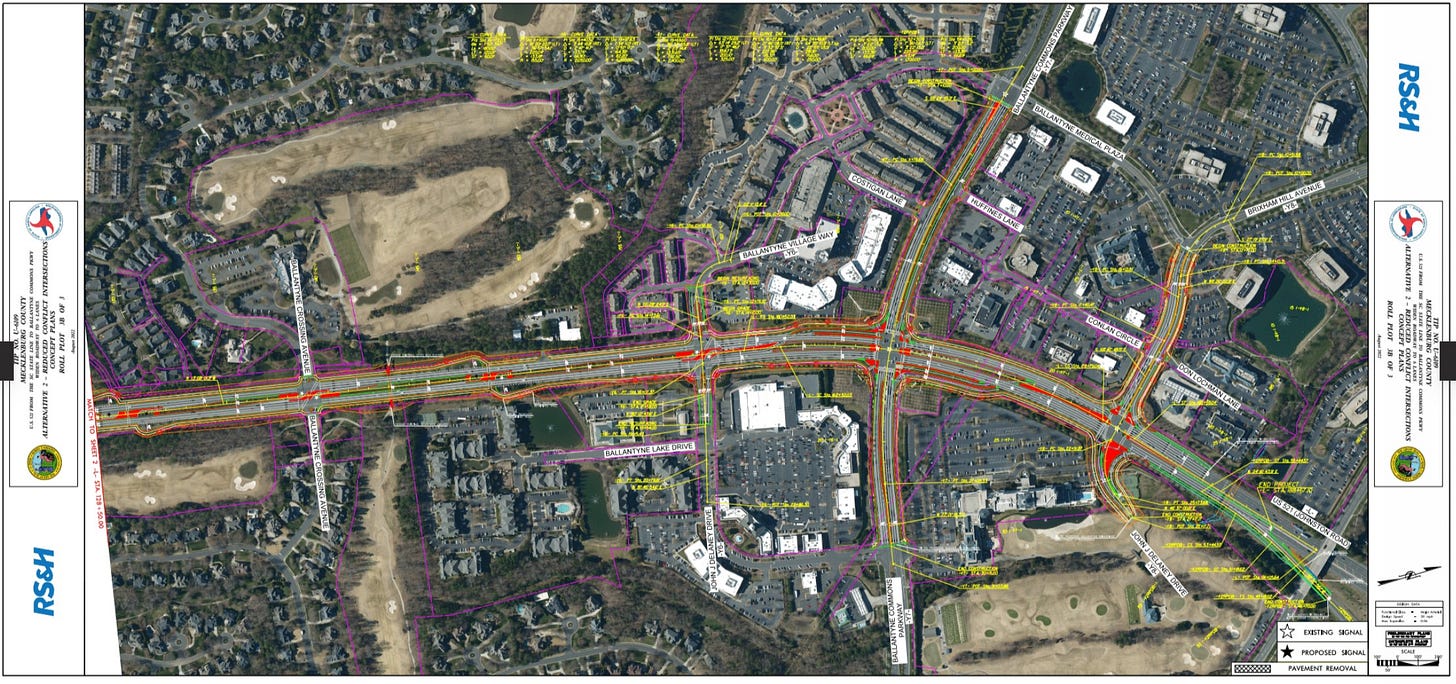Plans for Johnston Road widening could ban left turns from many cross streets
Transportation officials say 'reduced conflict intersections' are designed to improve traffic flow; project still in early design phase
No left turns in Ballantyne? Early plans for widening of Johnston Road would make many intersections right-turn-only
by Cristina Bolling
North Carolina transportation officials are working on plans to widen Johnston Road in south Charlotte from I-485 to the South Carolina state line, and preliminary designs call for six lanes and a series of “reduced conflict intersections” that allow only right turns onto Johnston Road from streets that intersect it.
The proposed changes will no doubt benefit the flow of traffic, but will be a big initial adjustment for the thousands of people who live in neighborhoods or do business off Johnston Road, who will be forced to make right turns and then make U-turns if they need to go in the other direction.
Reduced conflict intersections are designed to simplify traffic flow and reduce accidents by eliminating left turns from side roads onto busy streets. To go left from a side street, drivers first turn right and then pull into a dedicated left lane and make a U-turn. (You can read more about reduced conflict intersections in this NCDOT article.)
Side streets impacted by the new reduced conflict intersections would include Ardrey Kell Road, Lancaster Highway, John J. Delaney Drive and Ballantyne Crossing Avenue. You can see draft maps here:
These draft maps of plans to expand Johnston Road south of I-485 to the South Carolina border show several “reduced conflict intersections.” The plans are in the early draft stages and are still subject to change, according to the N.C. Department of Transportation. (NCDOT)
N.C. Department of Transportation spokeswoman Jen Thompson told The Ledger that the department looked at options that included either keeping traditional intersections or using reduced conflict intersections, and “we chose to move forward with this alternative due to the improved traffic operations those alternative intersections would create.”
“Of the available options, this alternative provides the most benefits — improved safety, traffic operations and reduced congestion. As we mentioned before, the project is in early design, so this is not final and subject to change. There will be opportunities for public engagement later this year,” Thompson said in an email to The Ledger.
Thompson said the Board of Transportation will lock in the funding and the schedule for the widening project this May or June. Under the current draft of the State Transportation Improvement Plan, construction on Johnston Road would begin in 2026 and last for about three years. Right-of-way acquisition would happen in the 2024 fiscal year.
NCDOT held public comment sessions last summer and fall on the State Transportation Improvement Plan, Thompson said, and public comment sessions on the proposed plans for Johnston Road (also called U.S. 521) are still to come, possibly in the spring or summer of 2023.
Johnston Road is a tortured corridor that hasn’t kept pace with the booming development in the Ballantyne area and the volume of cars going to and from nearby South Carolina. Let’s put it this way — it’s not unusual during evening rush hour to see this guy holding a sign on a bridge above Johnston Road with a Bible verse warning gridlocked drivers to prepare for the second coming of Jesus:
Editor’s note: This article was updated Tuesday, Jan. 17 with information about plans for public comment sessions for the Johnston Road expansion, and a more thorough explanation from an NCDOT official about the benefits of reduced conflict intersections and plans for public comment.
Related Ledger article:
“Iconic Ballantyne monuments endangered by planned road widening” (Sept. 21, 2022)
Need to sign up for this e-newsletter? We offer a free version, as well as paid memberships for full access to all 4 of our local newsletters:
➡️ Opt in or out of different newsletters on your “My Account” page.
➡️ Learn more about The Charlotte Ledger
The Charlotte Ledger is a locally owned media company that delivers smart and essential news through e-newsletters and on a website. We strive for fairness and accuracy and will correct all known errors. The content reflects the independent editorial judgment of The Charlotte Ledger. Any advertising, paid marketing, or sponsored content will be clearly labeled.
Like what we are doing? Feel free to forward this along and to tell a friend.
Social media: On Facebook, Instagram, Twitter and LinkedIn.
Sponsorship information/customer service: email support@cltledger.com.
Executive editor: Tony Mecia; Managing editor: Cristina Bolling; Staff writer: Lindsey Banks; Contributing editor: Tim Whitmire, CXN Advisory; Contributing photographer/videographer: Kevin Young, The 5 and 2 Project






